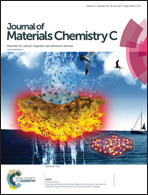One-step synthesis and self-assembly of a luminescent sponge-like network of gold nanoparticles with high absorption capacity†
Abstract
We report a facile one-step strategy to fabricate luminescent gold nanoparticles (AuNPs) assembled in a sponge-like network with a high capacity for Hg(II) absorption. The tetrathiol pentaerythritol tetrakis 3-mercaptopropionate (PTMP) was employed as both reducing agent and surface coating ligand in the synthesis of 2.4 ± 0.4 nm luminescent PTMP–AuNPs. PTMP also acted as a crosslinker in the formation of a sponge-like network of AuNPs due to thiol-bridging between the ultrasmall PMPT-AuNPs, which resulted in insoluble red-emissive macroscopic aggregates with maximum wavelength at 675 nm followed by a synergistic hydrophobic effect of the surface ligands. Dispersion of the macroscopic aggregates was enhanced using a typical surfactant-assisted method under sonication but did not change the morphology of the sponge-like network of PTMP–AuNPs. The as-prepared sponge-like network of AuNPs provided a good reservoir for the capture of heavy metal ions, and showed a saturation capacity of 2.48 g Hg(II) per gram of sorbent due to the synergistic interaction from both the high porosity of the sponge-like structure and the high-affinity metallophilic Hg(II)–Au(I) interactions. In addition, the excellent optical performance of the network along with the specific and strong closed-shell metal interaction led to a sensitive and selective platform for Hg(II) sensing. Therefore, the sponge-like network of PTMP–AuNPs may find potential applications in Hg(II) detection and elimination from drinking water.



 Please wait while we load your content...
Please wait while we load your content...